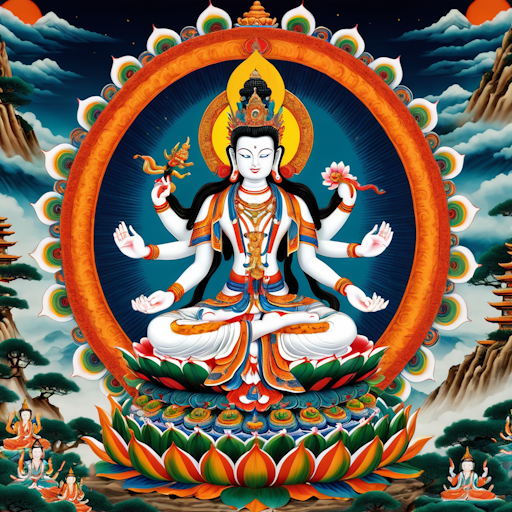Buddhism, a profound spiritual and philosophical tradition, offers a path to awakening, known as “bodhi,” which signifies the end of ignorance, suffering, and the cycle of rebirth. A bodhisattva is a person walking this path, driven not only by the aspiration to achieve bodhi for themselves but also to assist all sentient beings in their journey towards enlightenment. In this article, we will delve into the role of bodhisattvas in Buddhist tradition, explore captivating stories of renowned bodhisattvas, and learn how to nurture the bodhisattva spirit in our own lives.
The Role of Bodhisattvas in Buddhist Tradition

The concept of a bodhisattva can vary in interpretation across different schools of Buddhism. In Theravada Buddhism, the oldest and most widespread form of Buddhism in Southeast Asia, a bodhisattva is a rare individual who renounces their own attainment of nirvana, the ultimate liberation from samsara, the cycle of birth and death. They choose to remain in the world to help others. A prominent example of a Theravada bodhisattva is Maitreya, the future Buddha, believed to reside in the Tusita heaven, awaiting the right time to descend to Earth and share the Dharma, the teachings of Buddhism.

In Mahayana Buddhism, the dominant form of Buddhism in East and Central Asia, a bodhisattva is a more inclusive ideal accessible to all Buddhists. Mahayana practitioners believe that anyone who generates bodhicitta, the mind of awakening, is a bodhisattva. Bodhicitta is a spontaneous and altruistic intention to become a Buddha for the sake of all beings. Mahayana Buddhism also venerates many celestial bodhisattvas, advanced beings with supernatural powers and wisdom, who have postponed their own enlightenment to help others. These bodhisattvas embody various aspects of the Buddha’s qualities, such as compassion, wisdom, skillful means, and activity.

Stories of Famous Bodhisattvas

Buddhist literature and art are replete with captivating stories and legends about bodhisattvas. These stories not only serve as sources of inspiration and guidance for Buddhists but also provide a window into the core values and worldview of Buddhism. Here are some examples:
- Avalokiteshvara: Revered as the embodiment of compassion, Avalokiteshvara vowed to liberate all beings from suffering. When confronted with the vast number of beings trapped in the six realms of existence, he became overwhelmed, and his head split into eleven pieces. The Buddha Amitabha came to his rescue, granting him eleven heads and a thousand arms, each with an eye and a hand, to reach out to all beings in need. Avalokiteshvara takes on different forms across various Buddhist cultures, known as Guanyin in China, Kannon in Japan, and Chenrezig in Tibetan Buddhism.
- Manjushri: As the bodhisattva of wisdom, Manjushri wields a flaming sword that symbolizes his power to cut through ignorance and delusion. In a famous story, Manjushri visited Buddha Vimalakirti during a discourse on the Lotus Sutra, considered one of the most significant texts in Mahayana Buddhism. Instead of explaining the sutra in words, Manjushri performed a series of miraculous feats, demonstrating the profound teachings through actions. This display illustrated the essence of the Dharma, which transcends mere words and concepts.
- Ksitigarbha: Ksitigarbha, the bodhisattva of the underworld, vowed to save all beings from the hell realms. One notable story recounts how he visited his mother in hell, witnessing her suffering due to karmic consequences. Touched by her plight, he pledged to dedicate all his merits to liberate her and all others from hell, delaying his own buddhahood until every hell is emptied. Ksitigarbha is also revered as the guardian of children, especially those who passed away before their parents, protecting them from the torments of hell and guiding them to rebirth in the Pure Land.
Cultivating the Bodhisattva Spirit
The bodhisattva spirit encompasses the aspiration to attain awakening for the benefit of all beings, along with a commitment to practice the six perfections: generosity, morality, patience, diligence, meditation, and wisdom. To nurture the bodhisattva spirit within ourselves, we can follow these steps:
- Practice Self-Compassion: Recognize that how we treat ourselves extends into the world. Practice loving-kindness and forgiveness towards yourself while acknowledging your potential for buddhahood.
- Acts of Kindness: Engage in acts of generosity and morality by helping those in need, sharing resources, and avoiding harm to all living beings. Practice patience and diligence by enduring hardships and persisting in your spiritual journey.
- Craft Your Bodhisattva Vow: Express your intention to become a bodhisattva in your own words and recite it regularly for motivation. Join a community of fellow bodhisattvas and seek guidance from a teacher or mentor.
- Examine Your Actions: Practice meditation and wisdom by introspectively exploring your thoughts and actions, recognizing the influence of ignorance, attachment, and aversion. Study the teachings of the Buddha and the bodhisattvas, applying them to your daily life.
- Cultivate Loving-Kindness: Develop empathy and understanding for all beings, finding ways to benefit them according to their needs and capacities. Draw inspiration and seek the blessings of the Buddha and the bodhisattvas.
The bodhisattva ideal lies at the heart of Buddhism, embodying the highest potential of humanity. By nurturing the bodhisattva spirit, we can transform ourselves and the world, ultimately achieving the goal of awakening.
Useful Links